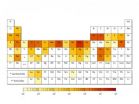(Press-News.org) March 27, 2015 - For people with low vision who need bioptic telescopic glasses to drive, previous driving experience and the need for more training hours are the main factors affecting performance on driver's license road tests, according to a study in the April issue of Optometry and Vision Science, official journal of the American Academy of Optometry. The journal is published by Wolters Kluwer.
After driving experience is taken into account, visual factors have no significant effect on road test scores in drivers using bioptic devices, report Bradley E. Dougherty, OD, PhD, FAAO, of The Ohio State University College of Optometry and colleagues. "This study suggests that judgments by driving trainers and the previous driving experience of new bioptic telescope drivers is predictive of driving performance," according to the researchers.
What Factors Affect Road Test Results in Bioptic Drivers?
Bioptic telescopic devices attached to a pair of the glasses may permit driving with a special license by some people with decreased central vision but adequate peripheral vision. When they need to see more distant objects, drivers can tilt the head downward to obtain a telescopic view.
Forty-three states currently issue bioptic telescope licenses for appropriate candidates, after special training and testing. However, amid ongoing debate over these special licenses, there is little information on factors affecting driving performance or safety in bioptic drivers.
To address this issue, the researchers analyzed the results of Highway Patrol road tests in 74 Ohio drivers who received bioptic licenses, whether on their first test or on repeat testing. Participants were identified through the bioptic telescope driving program at Ohio State program, which trains about three-fourths of bioptic drivers statewide.
Previous driving experience--before telescopic lenses were needed--was the single strongest predictor of the road test results. "Forty-one percent of candidates without previous driving experience passed the Highway Patrol exam on the first attempt, compared to 81 percent of those with experience," Dr Dougherty and colleagues write.
Hours of bioptic driver training were also a significant factor--candidates who needed more training actually performed worse on the road test. Median training time was 33 hours for candidates who failed at least one portion of the road test, compared to 17 hours for those who passed on their first attempt.
While that may seem counterintuitive, the difference in training hours likely reflected the trainer's belief that the person was not yet ready for the road test. The effect of training hours on road test results remained significant even after adjustment for previous, non-bioptic driving experience.
Candidates with involuntary eye movement (nystagmus)--often younger patients who often had congenital vision disorders and no previous driving experience--also performed worse on road tests. Otherwise, performance was not significantly affected by visual acuity or other visual factors.
"[P]atients with a wide range of visual profiles appear to be able to perform the tasks associated with training and testing for bioptic driving licensure," Dr Dougherty and colleagues write. "This will continue to make it difficult for patients, clinicians, and administrators of bioptic programs to predict the amount of time likely to be needed for driver training or the likely results for licensure based on the visual or demographic characteristics of the drivers."
The researchers call for further studies to help identify the most effective training regimen for bioptic drivers. Anthony Adams, OD, PhD, Editor-in-Chief of Optometry and Vision Science, comments, "It also remains to be studied whether road test results, per se, are predictive of accidents after licensing for bioptic drivers."
INFORMATION:
Click here to read ""Vision, Training Hours, and Road Testing Results in Bioptic Drivers"
Article: "Vision, Training Hours, and Road Testing Results in Bioptic Drivers" (doi: 10.1097/OPX.0000000000000547)
About Optometry and Vision Science
Optometry and Vision Science, official journal of the American Academy of Optometry, is the most authoritative source for current developments in optometry, physiological optics, and vision science. This frequently cited monthly scientific journal has served primary eye care practitioners for more than 75 years, promoting vital interdisciplinary exchange among optometrists and vision scientists worldwide.
About the American Academy of Optometry
Founded in 1922, the American Academy of Optometry is committed to promoting the art and science of vision care through lifelong learning. All members of the Academy are dedicated to the highest standards of optometric practice through clinical care, education or research.
About Wolters Kluwer
Wolters Kluwer is a global leader in professional information services. Professionals in the areas of legal, business, tax, accounting, finance, audit, risk, compliance and healthcare rely on Wolters Kluwer's market leading information-enabled tools and software solutions to manage their business efficiently, deliver results to their clients, and succeed in an ever more dynamic world.
Wolters Kluwer reported 2014 annual revenues of €3.7 billion. The group serves customers in over 170 countries, and employs over 19,000 people worldwide. The company is headquartered in Alphen aan den Rijn, the Netherlands. Wolters Kluwer shares are listed on NYSE Euronext Amsterdam (WKL) and are included in the AEX and Euronext 100 indices. Wolters Kluwer has a sponsored Level 1 American Depositary Receipt program. The ADRs are traded on the over-the-counter market in the U.S. (WTKWY).
For more information about our products and organization, visit http://www.wolterskluwer.com, follow @WKHealth or @Wolters_Kluwer on Twitter, like us on Facebook, follow us on LinkedIn, or follow WoltersKluwerComms on YouTube.
Cold snaps like the ones that hit the eastern United States in the past winters are not a consequence of climate change. Scientists at ETH Zurich and the California Institute of Technology have shown that global warming actually tends to reduce temperature variability.
Repeated cold snaps led to temperatures far below freezing across the eastern United States in the past two winters. Parts of the Niagara Falls froze, and ice floes formed on Lake Michigan. Such low temperatures had become rare in recent years. Pictures of icy, snow-covered cities made their way around ...
University of Notre Dame applied mathematician Mark Alber and environmental biotechnologist Robert Nerenberg have developed a new computational model that effectively simulates the mechanical behavior of biofilms. Their model may lead to new strategies for studying a range of issues from blood clots to waste treatment systems.
"Blood clotting is a leading cause of death in the United States at this point," said Alber, who is The Vincent J. Duncan Family Professor of Applied Mathematics in the College of Science and an adjunct professor of medicine at the Indiana University ...
TEMPE, Ariz. (March 27, 2015) - As more people move to different regions of the country it will require planners to use as many tools as they can to develop urban areas that satisfy population demands and not over burden the environment.
A new study from Arizona State University (ASU) details some of the dynamics at play as one region of the country, the Central Valley of California, braces for substantial population growth and all it entails. The study, based on computer simulations using the ASU Advanced Computing Center, of rural to urban land conversion shows that ...
March 27, 2015--A study by researchers at Columbia University's Mailman School of Public Health and colleagues in the Netherlands evaluated the relationship between nutritional conditions in very early life and adult health, and found that famine exposure during the first pregnancy trimester was associated with increases in mortality from a variety of causes other than cancer or cardiovascular disease.
This is the first study to quantify the possible long-term effects of nutrition deprivation at different stages of pregnancy and long-term mortality from causes of death ...
BUFFALO, N.Y. - A big bowl of mashed potatoes. What about spaghetti and meatballs? Sushi? Regardless of what you identify as comfort food, it's likely the attraction to that dish is based on having a good relationship with the person you remember first preparing it, according to the results of a new study by a University at Buffalo research team.
The findings have implications for better understanding how social factors influence our food preferences and eating behavior.
"Comfort foods are often the foods that our caregivers gave us when we were children. As long we ...
Milan, Italy - March 28, 2015 Research looking at risk of early mortality of British middle-aged women and osteoarthritis was presented today at the World Congress on Osteoporosis, Osteoarthritis and Musculoskeletal Diseases. It shows that any painful knee osteoarthritis is strongly associated with early overall and cardiovascular mortality. Interestingly these findings are independent to most of the known risk factors linked with early mortality. The study was based on the data from the Chingford Study. This is community based data from a cohort of middle-aged women followed ...
TORONTO, ON - What do butterflies, spiders and lobsters have in common? They are all surviving relatives of a newly identified species called Yawunik kootenayi, a marine creature with two pairs of eyes and prominent grasping appendages that lived as much as 508 million years ago - more than 250 million years before the first dinosaur.
The fossil was identified by an international team led by palaeontologists at the University of Toronto (U of T) and the Royal Ontario Museum (ROM) in Toronto, as well as Pomona College in California. It is the first new species to be described ...
Reclusive giant pandas fascinate the world, yet precious little is known about how they spend their time in the Chinese bamboo forests. Until now.
A team of Michigan State University (MSU) researchers who have been electronically stalking five pandas in the wild, courtesy of rare GPS collars, have finished crunching months of data and has published some panda surprises in this month's Journal of Mammalogy.
"Pandas are such an elusive species and it's very hard to observe them in wild, so we haven't had a good picture of where they are from one day to the next," said ...
Music performance is known to induce structural and functional changes to the human brain and enhance cognition. However, the molecular mechanisms underlying music performance have been so far unexplored. A Finnish research group has now investigated the effect of music performance (in a 2 hr concert) on the gene expression profiles of professional musicians from Tapiola Sinfonietta (a professional orchestra) and Sibelius-Academy (a music university).
Playing music enhanced the activity of genes involved in dopaminergic neurotransmission, motor function, learning and ...
In a new paper, a team of Yale researchers assesses the "criticality" of all 62 metals on the Periodic Table of Elements, providing key insights into which materials might become more difficult to find in the coming decades, which ones will exact the highest environmental costs -- and which ones simply cannot be replaced as components of vital technologies.
During the past decade, sporadic shortages of metals needed to create a wide range of high-tech products have inspired attempts to quantify the criticality of these materials, defined by the relative importance of ...


